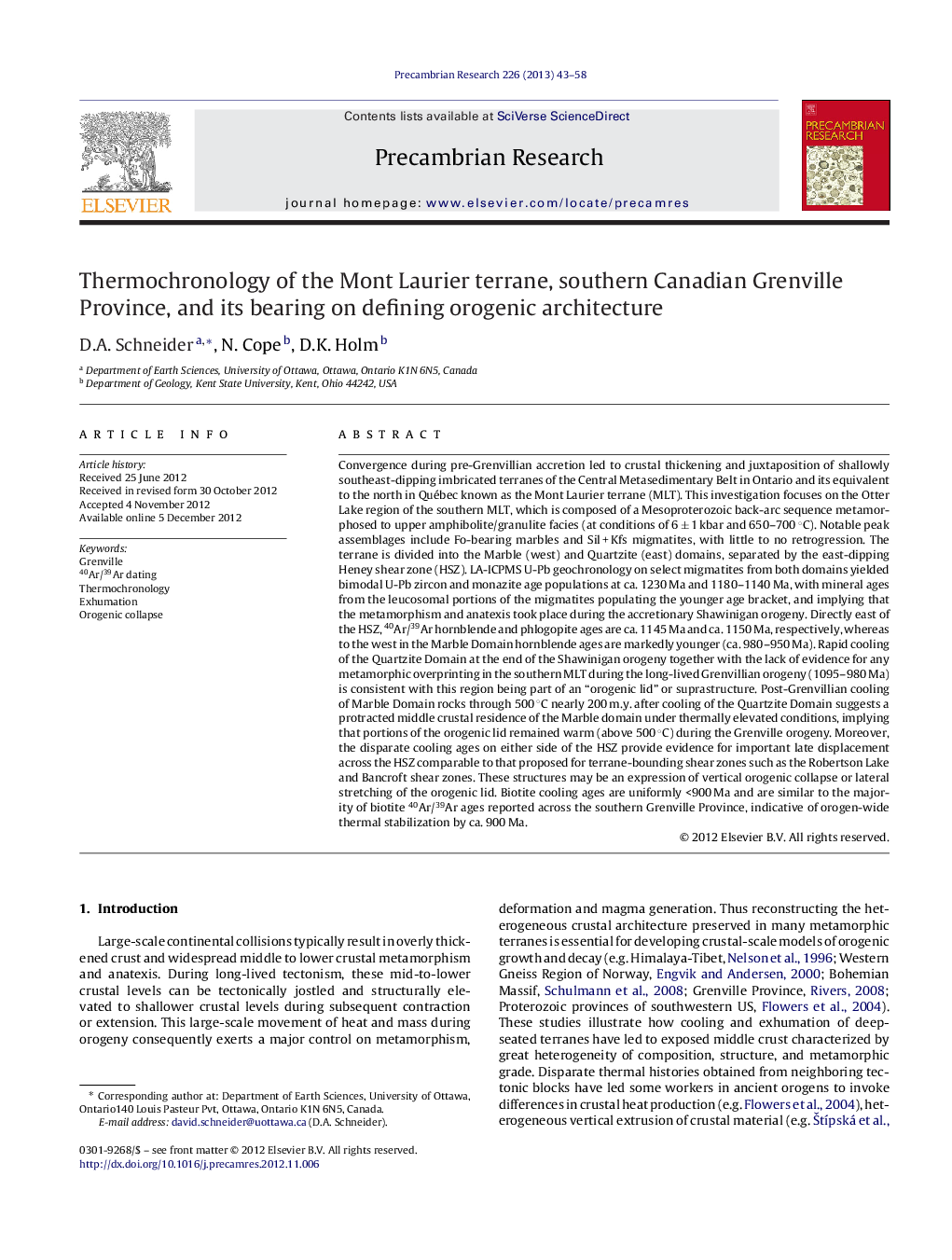| کد مقاله | کد نشریه | سال انتشار | مقاله انگلیسی | نسخه تمام متن |
|---|---|---|---|---|
| 4723378 | 1639648 | 2013 | 16 صفحه PDF | دانلود رایگان |
Convergence during pre-Grenvillian accretion led to crustal thickening and juxtaposition of shallowly southeast-dipping imbricated terranes of the Central Metasedimentary Belt in Ontario and its equivalent to the north in Québec known as the Mont Laurier terrane (MLT). This investigation focuses on the Otter Lake region of the southern MLT, which is composed of a Mesoproterozoic back-arc sequence metamorphosed to upper amphibolite/granulite facies (at conditions of 6 ± 1 kbar and 650–700 °C). Notable peak assemblages include Fo-bearing marbles and Sil + Kfs migmatites, with little to no retrogression. The terrane is divided into the Marble (west) and Quartzite (east) domains, separated by the east-dipping Heney shear zone (HSZ). LA-ICPMS U-Pb geochronology on select migmatites from both domains yielded bimodal U-Pb zircon and monazite age populations at ca. 1230 Ma and 1180–1140 Ma, with mineral ages from the leucosomal portions of the migmatites populating the younger age bracket, and implying that the metamorphism and anatexis took place during the accretionary Shawinigan orogeny. Directly east of the HSZ, 40Ar/39Ar hornblende and phlogopite ages are ca. 1145 Ma and ca. 1150 Ma, respectively, whereas to the west in the Marble Domain hornblende ages are markedly younger (ca. 980–950 Ma). Rapid cooling of the Quartzite Domain at the end of the Shawinigan orogeny together with the lack of evidence for any metamorphic overprinting in the southern MLT during the long-lived Grenvillian orogeny (1095–980 Ma) is consistent with this region being part of an “orogenic lid” or suprastructure. Post-Grenvillian cooling of Marble Domain rocks through 500 °C nearly 200 m.y. after cooling of the Quartzite Domain suggests a protracted middle crustal residence of the Marble domain under thermally elevated conditions, implying that portions of the orogenic lid remained warm (above 500 °C) during the Grenville orogeny. Moreover, the disparate cooling ages on either side of the HSZ provide evidence for important late displacement across the HSZ comparable to that proposed for terrane-bounding shear zones such as the Robertson Lake and Bancroft shear zones. These structures may be an expression of vertical orogenic collapse or lateral stretching of the orogenic lid. Biotite cooling ages are uniformly <900 Ma and are similar to the majority of biotite 40Ar/39Ar ages reported across the southern Grenville Province, indicative of orogen-wide thermal stabilization by ca. 900 Ma.
► The southern Mont Laurier terrane was metamorphosed under upper amphibolite facies with Fo-bearing marbles and Sil-bearing gneisses.
► High-temperature geochronology of migmatites within the terrane indicates Shawinigan (1180–1140 Ma) anatexis.
► The terrane is a Grenvillian orogenic lid which saw protracted middle crustal residence under thermally elevated conditions.
► Thermochronology from the terrane suggests slow cooling nearly 200 m.y. after metamorphism.
► The two domains are separated by the Heney shear zone, a c. 980–940 Ma extensional collapse structure.
Journal: Precambrian Research - Volume 226, March 2013, Pages 43–58
